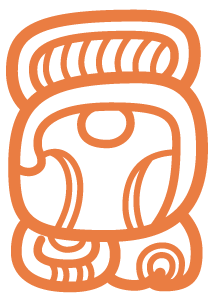

Tzec corresponds to the day Lamat in the tzolk'in sequence. One meaning of tzec is "skull", but in hieroglyphic spellings the month name reads Kasew, the Pacaya palm tree, the unopened male flowers of which are edible. Another sense of tzec is "end" or "end of the 260-day count." The glyph for the month Tzec has a "comb" prefix, which is combined with a winal (month) sign.
The day Lamat is most specifically associated with Venus, but also with "star" and "rabbit." However, lamat has been said to be a non-Maya word and is believed to have come into Mayan (as lambat) from Zapotec.
The Diccionario maya-español (Yukatekan), on the other hand, gives lam as "flood" and lamats as "to sink" (as in a boat sinking below the water, or the sun setting below the horizon). This solar interpretation, rather than that of Venus or stars, relates fairly well to an interpretation that Tzec/Sek/Lamat ended a cycle at some point, with the sun figuratively in (or ready to begin to move out of) the Underworld, that is, below zenith.
Adapted from Rice, P. M. (2007). Maya Calendar Origins: Monuments, Mythistory, and the Materialization of Time. p. 89. Austin: University of Texas Press.
Tzec corresponde al día Lamat en la secuencia tzolk'in. Un significado de tzec es "calavera", pero lecturas jeroglíficas el nombre del mes se lee Kasew, la palmera Pacaya, las flores masculinas sin abrir las cuales son comestibles. Otro significado de tzec es "fin" o "fin de la cuenta de 260 días." El glifo para el mes tzec tiene un prefijo de "peine", el cual se combina con un signo de winal (mes).
El día Lamat está específicamente asociado a Venus en su mayoría, pero también lo está con "estrella" y "conejo." Sin embargo, se ha dicho que lamat no es una palabra maya y se cree que fue introducida al maya (como lambat) del Zapoteco.
El Diccionario maya-español (maya yucateco), por otro lado, define lam como "inundación" y lamats como "hundirse" (como en un bote hundiéndose en el agua, o el sol ocultándose en el horizonte). Esta intepretación solar, mas que estar relacionada con aquella referente a Venus o las estrellas, se relaciona bastante bien con una interpretación de que Tzec/Sek/Lamat finaliza un ciclo en cierto momento, con el sol figurativamente dentro (o listo para comenzar a salir) del inframundo; esto es, debajo del cenit.
Adaptado de Rice, P. M. (2007). Maya Calendar Origins: Monuments, Mythistory, and the Materialization of Time. p. 89. Austin: University of Texas Press.
